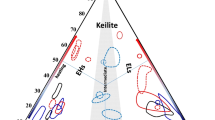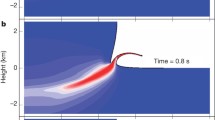Abstract
Chondrules1,2,3,4,5 are millimetre-sized, solidified melt spherules formed in the solar nebula by an early widespread heating event of uncertain nature6,7,8. They were accreted into chondritic asteroids, which formed about 4.56 billion years ago and have not experienced melting or differentiation since that time. Chondrules have diverse chemical compositions, corresponding to liquidus temperatures1,4,9 in the range 1,350–1,800 °C. Most chondrules, however, show porphyritic textures (consisting of large crystals in a distinctly finer grained or glassy matrix), indicative of melting within the narrow range 0–50 °C below the liquidus9,10. This suggests an unusual heating mechanism for chondrule precursors, which would raise each individual chondrule to just the right temperature (particular to individual bulk composition) in order to form porphyritic textures. Here we report the results of isothermal melting of a chondritic composition at nebular pressures. Our results suggest that evaporation stabilizes porphyritic textures over a wider range of temperatures below the liquidus (about 200 °C) than previously believed, thus removing the need for individual chondrule temperature buffering. In addition, we show that evaporation explains many chondrule bulk and mineral compositions that have hitherto been difficult to understand.



Similar content being viewed by others
References
McSween, H. Y. Jr Chemical and petrographic constraints on the origin of chondrules and inclusions in carbonaceous chondrites. Geochim. Cosmochim. Acta 41, 1843–1860 (1977).
Grossman, J. N. in Meteorites and the Early Solar System (eds Kerridge, J. F. & Matthews, M. S.) 680–696 (Univ. Arizona Press, Tucson, 1988).
Sears, D. W. G., Huang, S. & Benoit, P. H. in Chondrules and the Protoplanetary Disk (eds Hewins, R. H., Jones, R. H. & Scott, E. R. D.) 221– 231 (Cambridge Univ. Press, Cambridge, 1996).
Jones, R. H. FeO-rich, porphyritic pyroxene chondrules in unequilibrated ordinary chondrites. Geochim. Cosmochim. Acta 60, 3115– 3138 (1996).
Hewins, R. H. Chondrules. Annu. Rev. Earth Planet. Sci. 25, 61–83 (1997).
Cuzzi, J. N., Dobrovolskis, A. R. & Hogan, R. C. in Chondrules and the Protoplanetary Disk (eds Hewins, R. H., Jones, R. H. & Scott, E. R. D.) 35– 43 (Cambridge Univ. Press, Cambridge, 1996).
Boss, A. P. in Chondrules and the Protoplanetary Disk (eds Hewins, R. H., Jones, R. H. & Scott, E. R. D.) 257–263 (Cambridge Univ. Press, Cambridge, 1996).
Scott, E. R. D., Love, S. G. & Krot, A. N. in Chondrules and the Protoplanetary Disk (eds Hewins, R. H., Jones, R. H. & Scott, E. R. D.) 87– 96 (Cambridge Univ. Press, Cambridge, 1996).
Hewins, R. H. & Radomsky, P. M. Temperature conditions for chondrule formation. Meteoritics 25, 309– 318 (1990).
Lofgren, G. E. in Chondrules and the Protoplanetary Disk (eds Hewins, R. H., Jones, R. H. & Scott, E. R. D.) 187–196 (Cambridge Univ. Press, Cambridge, 1996).
Grossman, J. N., Rubin, A. E., Nagahara, H. & King, E. A. in Meteorites and the Early Solar System (eds Kerridge, J. F. & Matthews, M. S.) 619–659 (Univ. Arizona Press, Tucson, 1988).
Hewins, R. H., Yu, Y., Zanda, B. & Bourot-Denise, M. Do nebular fractionations, evaporative losses, or both, influence chondrule compositions? Antarct. Met. Res. 10, 294– 317 (1997).
Nagahara, H., Kushiro, I. & Mysen, B. O. Evaporation of olivine: low pressure phase relations of the olivine system and its implication for the origin of chondritic components in the solar system. Geochim. Cosmochim. Acta 58, 1951–1963 (1994).
Yu, Y. & Hewins, R. H. Transient heating and chondrule formation- evidence from Na loss in flash heating simulation experiments. Geochim. Cosmochim. Acta 62, 159– 172 (1998).
Anders, E. & Grevesse, N. Abundances of the elements: meteoritic and solar. Geochim. Cosmochim. Acta 53, 197–214 (1989).
Wood, J. A. & Hashimoto, A. Mineral equilibrium in fractionated nebular systems. Geochim. Cosmochim. Acta 57, 2377–2388 (1993).
Yu, Y. et al. Mass fractionation of K isotopes in chondrule evaporation experiments. Lunar Planet. Sci. XXIX, (1998 ).
Weinbruch, S., Palme, H. & Spettel, B. Refractory forsterite in primitive meteorites: Condensates from the solar nebula? Meteor. Planet. Sci 35, 161–171 (2000).
Alexander, C. M. O'D. in Chondrules and the Protoplanetary Disk (eds Hewins, R. H., Jones, R. H. & Scott, E. R. D.) 233–241 (Cambridge Univ. Press, Cambridge, 1996).
Jones, R. H. & Lofgren, G. E. A comparison of FeO-rich, porphyritic olivine chondrules in unequilibrated chondrites and experimental analogues. Meteoritics 28, 213–221 (1993).
Weinbruch, S. & Müller, W. F. Constraints on the cooling rates of chondrules from the microstructure of clinopyroxene and plagioclase. Geochim. Cosmochim. Acta 59, 3221– 3231 (1995).
Weinbruch, S., Buttner, H., Rosenhauer, M. & Hewins, R. H. On the lower limit of chondrule cooling rates. Meteor. Planet. Sci. 33, 65–74 ( 1998).
Walker, D., Jurewicz, S. & Watson, E. B. Adcumulus dunite growth in a laboratory thermal gradient. Contrib. Mineral. Petrol. 99, 306– 319 (1988).
Connolly, H. C. Jr & Hewins, R. H. Chondrules as products of dust collisions with totally molten droplets within a dust-rich nebular environment: an experimental investigation. Geochim. Cosmochim. Acta 59, 3231– 3246 (1995).
Acknowledgements
We thank S. Morse for starting materials and the Muséum National d’Histoire Naturelle in Paris for their support. This work was funded by NASA.
Author information
Authors and Affiliations
Corresponding author
Rights and permissions
About this article
Cite this article
Cohen, B., Hewins, R. & Yu, Y. Evaporation in the young solar nebula as the origin of ‘just-right’ melting of chondrules. Nature 406, 600–602 (2000). https://doi.org/10.1038/35020514
Received:
Accepted:
Issue Date:
DOI: https://doi.org/10.1038/35020514
- Springer Nature Limited





